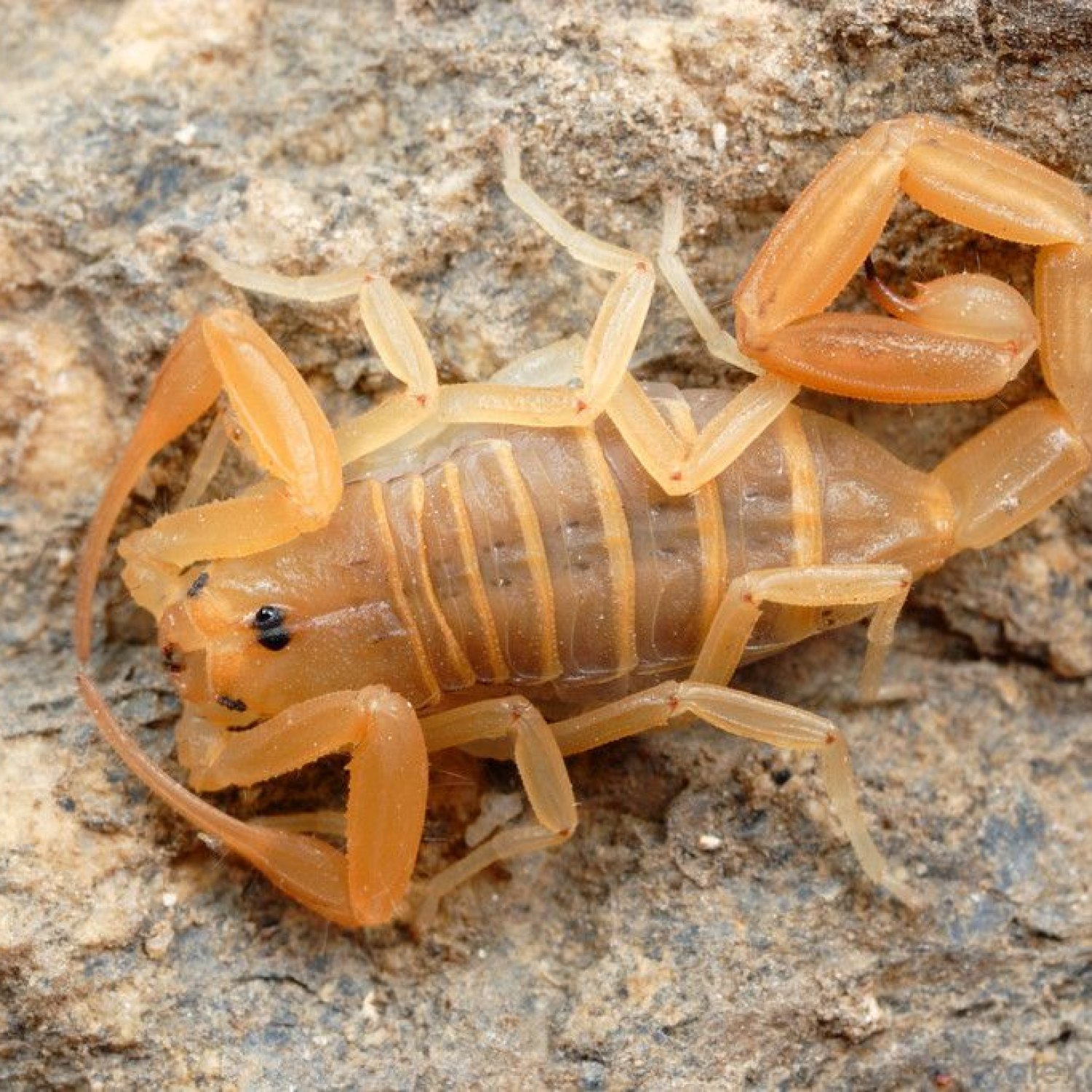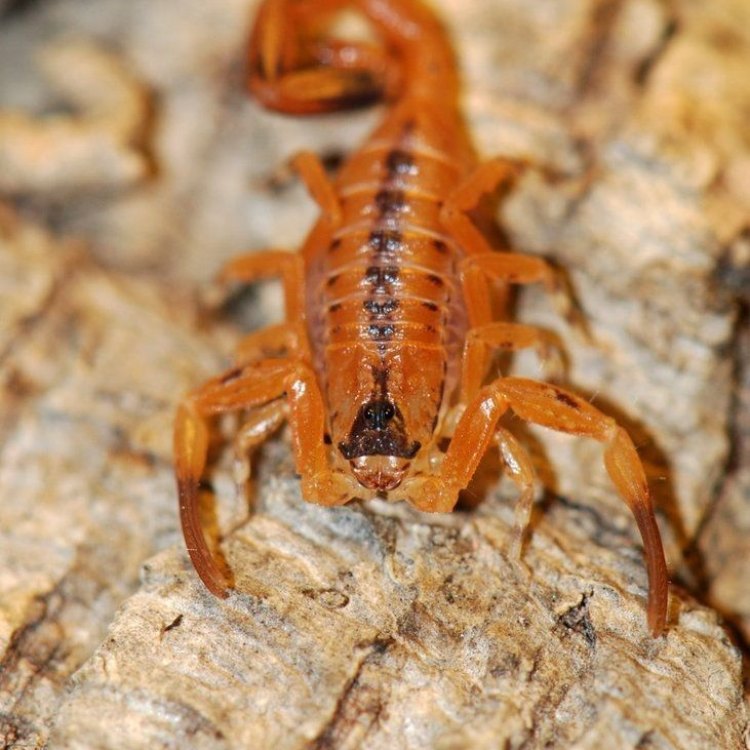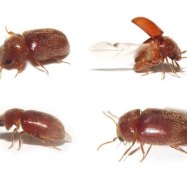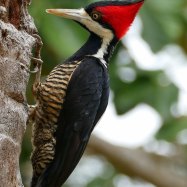
Bark Scorpion
2.0 to 3.1 inches
The Bark Scorpion is a small but deadly arachnid that can be found in rock crevices, under rocks, and in trees. With a slender and elongated body, they can grow up to 3.1 inches long and belong to the Buthidae family. Caution should be taken when encountering these creatures, as their venom can be dangerous. #Animals #BarkScorpion
Animal Details Summary:
Common Name: Bark Scorpion
Kingdom: Animalia
Habitat: Deserts and semi-arid regions
The Unique Features of the Bark Scorpion
Have you ever heard of a scorpion that can climb trees and rocks? That's right; we're talking about the Bark Scorpion, also known as Centruroides sculpturatus. This fascinating arachnid is found in the deserts and semi-arid regions of the Southwestern United States and northern Mexico. With its distinctive appearance and intriguing hunting behavior, the Bark Scorpion is an animal that has captivated the attention of many.Discovering the Kingdom of the Bark Scorpion
The Bark Scorpion belongs to the Kingdom Animalia, which includes all animals on Earth Bark Scorpion. Within the animal kingdom, scorpions are classified under the phylum Arthropoda. This phylum consists of animals with jointed limbs, a segmented body, and a hard exoskeleton. The class that the Bark Scorpion belongs to is Arachnida, which includes spiders, ticks, and mites.The Bark Scorpion is part of the order Scorpiones, which is comprised of about 1,500 species of scorpions. These creatures are characterized by their eight legs, front claws, and a venomous stinger located at the end of their tail. The family Buthidae includes some of the most venomous scorpions in the world, making the Bark Scorpion a close relative of the deadly Deathstalker and the Arizona Bark Scorpion.
The Bark Scorpion's Natural Habitat
The Bark Scorpion is primarily found in rocky, desert areas, where they thrive in the heat and arid climate. They can also be found in semi-arid regions, including grasslands and coastal areas. These scorpions prefer dry and dark environments, making them well-suited for living under rocks, in rock crevices, and even climbing trees Blacktip Reef Shark.Unlike other species of scorpions that burrow in the sand, the Bark Scorpion is a skilled climber. They use their hooked claws to grip onto rough surfaces and their long, slender body allows them to maneuver easily. This unique ability allows them to hunt for food in various locations, giving them a competitive advantage over other predators.
Feasting on Prey: The Carnivorous Diet of the Bark Scorpion
The Bark Scorpion is a carnivorous creature, meaning they feed on other animals. As nocturnal predators, they hunt at night, using their keen sense of smell and vibration detection to locate their prey. Their diet mainly consists of insects, such as crickets, beetles, and even other scorpions. They also have been known to prey on spiders and small reptiles.Using their front claws, the Bark Scorpion grasps onto their prey and subdues them with their venomous sting. The sting not only paralyzes their victim but also aids in the digestion process. This method of hunting allows the Bark Scorpion to consume food that is larger than their own body size, making them quick and efficient predators.
The Geographical Distribution of the Bark Scorpion
The natural range of the Bark Scorpion extends from southern Arizona, New Mexico, and Texas, to northern Mexico. They are also seen in parts of California, Nevada, and Utah. These scorpions prefer to inhabit dry and rocky terrain, which has influenced their distribution in these regions.While the majority of bark scorpions are found in the United States and Mexico, they have also been introduced to other parts of the world, including Central and South America, as well as Cuba. These introductions have been mainly due to transportation via plants or cargo.
The Colors and Shape of the Bark Scorpion
The Bark Scorpion has a unique and striking appearance, making them easily distinguishable from other scorpion species. They have light yellowish-tan to dark brown coloration, with two dark stripes running down their back. These stripes are believed to act as a form of camouflage, blending in with their desert surroundings.With a slender and elongated body shape, the Bark Scorpion can easily squeeze into tight spaces and camouflage themselves among rocks and twigs. Their body is covered in a hard exoskeleton, providing protection from predators and the harsh desert environment.
Size Matters: Measuring the Bark Scorpion
The average length of the Bark Scorpion is between 2.0 and 3.1 inches. While this may seem small, they are considered one of the largest species of scorpions in North America. Female Bark Scorpions tend to be larger than males, with their stinger being slightly longer and thinner.Despite their seemingly intimidating size, the Bark Scorpion is not known to be aggressive. They will only sting when threatened or provoked, making them relatively harmless creatures when left alone.
The Impact of the Bark Scorpion on Society
The Bark Scorpion is not only an intriguing and unique creature, but it has also had a significant impact on society. They have been the subject of many myths and legends, being portrayed as deadly and aggressive creatures. However, their venom has also been used for medicinal purposes, benefiting human health.In areas where the Bark Scorpion is prevalent, there have been reports of people being stung, with some cases resulting in severe allergic reactions, and even death in rare instances. This has led to an increase in public awareness and education about scorpion safety, with precautionary measures such as shaking out shoes and checking bedding before use.
Scorpions in Science and Medicine
Despite their notorious reputation, scorpions have also contributed to scientific advancements and research. The venom of the Bark Scorpion contains compounds that have shown potential in treating diseases such as multiple sclerosis, lupus, and rheumatoid arthritis.In addition, the Bark Scorpion's venom has been used to create a pain relief medication called "Prialt," which is highly effective in treating chronic pain. This discovery has opened up new possibilities in the medical field, making the Bark Scorpion a valuable resource for human health.
The Future of the Bark Scorpion
As with many species in the animal kingdom, the Bark Scorpion's future is closely tied to the protection of their natural habitat. Deforestation, urbanization, and climate change are all factors that have the potential to negatively impact the Bark Scorpion's ability to survive. In some areas, there have been efforts to control their population, which have led to a decrease in their numbers.However, in other areas, the Bark Scorpion is considered a beneficial predator, as they consume pests that can be harmful to crops and vegetation. As such, it is crucial to find a balance between managing their population and preserving their role in the ecosystem.
Becoming a Welcomed Neighbor
In recent years, there has been a shift in how people view scorpions, from pests to fascinating and essential creatures in the natural world. Educating the public about the Bark Scorpion and other scorpion species will help reduce fear and promote coexistence. Simple measures, such as sealing entry points and removing potential food sources, can also help prevent scorpions from making a home inside human dwellings.Conclusion
From their unique climbing abilities to their role in medicine, the Bark Scorpion is an animal that continues to intrigue and captivate. As with any living organism, understanding and respecting the Bark Scorpion and its importance in the ecosystem is crucial for its survival. With the right measures in place, we can continue to coexist peacefully with these fascinating creatures that roam the deserts and semi-arid regions of the southwestern United States and northern Mexico.

Bark Scorpion
Animal Details Bark Scorpion - Scientific Name: Centruroides sculpturatus
- Category: Animals B
- Scientific Name: Centruroides sculpturatus
- Common Name: Bark Scorpion
- Kingdom: Animalia
- Phylum: Arthropoda
- Class: Arachnida
- Order: Scorpiones
- Family: Buthidae
- Habitat: Deserts and semi-arid regions
- Feeding Method: Carnivorous
- Geographical Distribution: Southwestern United States and northern Mexico
- Country of Origin: United States and Mexico
- Location: Rock crevices, under rocks, and in trees
- Animal Coloration: Light yellowish-tan to dark brown
- Body Shape: Slender and elongated
- Length: 2.0 to 3.1 inches

Bark Scorpion
- Adult Size: 2.0 to 3.1 inches
- Average Lifespan: 3 to 5 years
- Reproduction: Sexual
- Reproductive Behavior: Mating occurs during the summer and autumn
- Sound or Call: No sound or call
- Migration Pattern: No specific migration pattern
- Social Groups: Solitary
- Behavior: Nocturnal and secretive
- Threats: Predators and habitat loss
- Conservation Status: Not listed
- Impact on Ecosystem: Control of insect populations
- Human Use: None
- Distinctive Features: Long tail, pincers, and venomous stinger
- Interesting Facts: The bark scorpion is the most venomous scorpion species in North America
- Predator: Birds, reptiles, and mammals

Centruroides sculpturatus
The Enigmatic Bark Scorpion: Solitary, Venomous, and Essential for Ecosystem Balance
When you hear the word scorpion, you may think of a creature with a menacing appearance and a deadly sting. And while this may be true for some scorpion species, there is one particular scorpion that stands out as the most venomous and fascinating of them all - the bark scorpion. Native to the deserts of North America, the bark scorpion's unique features and behaviors make it an enigmatic and vital member of its ecosystem.So, what sets the bark scorpion apart from other scorpion species? Let's take a closer look at its physical characteristics, behaviors, and ecological importance to uncover the mysteries behind this remarkable arachnid PeaceOfAnimals.Com.
Physical Features
The bark scorpion, also known as Centruroides exilicauda, is a small yet striking creature, measuring between 2.0 to 3.1 inches in length. It has a slender body with eight legs, two pedipalps (pincers), and a long, segmented tail. Its reddish-brown color, coupled with its long and thin appearance, gives it a striking resemblance to a tree bark, hence its name.
One of the most distinctive features of the bark scorpion is its venomous stinger, which is located at the end of its tail. Unlike other scorpion species, the bark scorpion can control the amount of venom it injects, making its sting potentially lethal. Even though its venom is highly toxic, it is only fatal to young children, elderly individuals, or those with weakened immune systems. For healthy adults, a bark scorpion sting can be very painful, but not life-threatening Bombay.
Another feature that sets the bark scorpion apart is its nocturnal and secretive nature. It has adapted to the desert environment by developing a thin, waxy coating on its exoskeleton, allowing it to retain moisture and survive in extreme heat. It also has tiny, comb-like structures on its legs that help it detect vibrations, making it highly sensitive to its surroundings.
Behaviors
As a solitary creature, the bark scorpion spends most of its life alone, only coming together with others during the mating season. Speaking of reproduction, the bark scorpion follows a sexual method of reproduction, with mating occurring during the summer and autumn months.
Interestingly, bark scorpions do not produce any sound or call, unlike other scorpion species. Instead, they communicate through touch and chemical signals, also known as pheromones. Males use their long pedipalps to grasp onto the female's pincers during courtship, and if successful, they will mate and then continue on their solitary ways.
The bark scorpion has no specific migration pattern and is mostly found in rocky areas, under stones, and in crevices of buildings or trees. They are also known to hide in damp areas, such as basements or bathrooms, seeking shelter and prey. This behavior makes it difficult to spot these creatures in the wild, adding to their mysterious nature.
Ecological Importance
Despite their venomous stings, bark scorpions play a crucial role in their ecosystem, particularly in regulating insect populations. As nocturnal hunters, they feed on a variety of insects, such as crickets, cockroaches, and even other scorpions, keeping their numbers in check. Without this natural predator, these insect populations could spiral out of control, causing ecological imbalances.
Additionally, bark scorpions are an important food source for other animals in their habitat, such as birds, reptiles, and mammals. Their presence in the food chain helps maintain the delicate balance of the ecosystem, highlighting their crucial role in the desert ecosystem.
Threats and Conservation Status
The bark scorpion, despite its venomous sting, does not pose a significant threat to humans. However, it does face threats from predators, such as birds, reptiles, and mammals, who hunt them for food. Habitat destruction and fragmentation also pose a danger to their survival.
However, due to their adaptability and wide distribution, the bark scorpion is not considered endangered or threatened. It is not listed on the IUCN Red List and has no conservation status. Nevertheless, it is essential to recognize the importance of protecting its habitat to ensure the survival of this unique creature and the balance of its ecosystem.
Interesting Facts
Apart from being the most venomous scorpion species in North America, the bark scorpion has many other interesting facts that make it stand out. Here are some of them:
- The bark scorpion's venom contains neurotoxins that can cause severe pain, numbness, and muscle contractions in humans.
- Despite their aggressive appearance, bark scorpions are timid creatures and will only sting in self-defense when threatened.
- In addition to insects, bark scorpions have also been known to feed on small reptiles, such as lizards.
- Some Native American tribes use the bark scorpion's venom in their traditional medicines to treat various ailments.
- Researchers are also studying the bark scorpion's venom to develop new painkillers and potentially cancer-fighting drugs.
Conclusion
In conclusion, the bark scorpion may seem like a fearsome and dangerous creature, but it is an essential and fascinating member of the desert ecosystem. Its unique physical features and behaviors make it an enigmatic and elusive creature, while its ecological importance cannot be overstated. As we continue to learn more about these creatures, it is crucial to recognize and appreciate their role in maintaining the balance of their habitat. So next time you come across a bark scorpion, remember not to be afraid, but rather, be in awe of these remarkable creatures and their vital contribution to the natural world.

The Unique Features of the Bark Scorpion
Disclaimer: The content provided is for informational purposes only. We cannot guarantee the accuracy of the information on this page 100%. All information provided here may change without prior notice.












